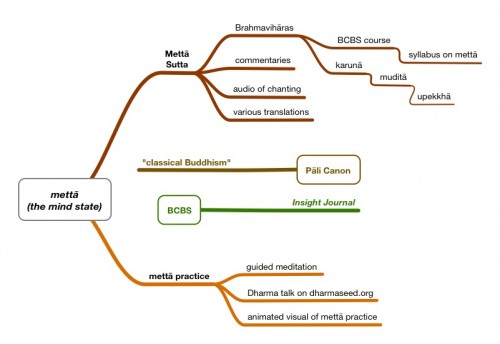It was about three  years ago that the Barre Center for Buddhist Studies (BCBS) first started distributing Dharma teachings by email on the full moon of each month, and about eighteen months ago the printed version of the Insight Journal became the electronically distributed full moon Insight Journal. Chris Talbott, who had been managing the production of these publications for several years, became the editor of the new offering, taking over the role from Andrew Olendzki, the BCBS senior scholar.
years ago that the Barre Center for Buddhist Studies (BCBS) first started distributing Dharma teachings by email on the full moon of each month, and about eighteen months ago the printed version of the Insight Journal became the electronically distributed full moon Insight Journal. Chris Talbott, who had been managing the production of these publications for several years, became the editor of the new offering, taking over the role from Andrew Olendzki, the BCBS senior scholar.
The transition was a quiet one, and many readers may not even have been aware of it. With the maturation of the Insight Journal in its present form, and many new and exciting developments on the way, it seems a good time for the BCBS community to become better acquainted with the person behind so many of these changes. Chris Talbott is interviewed here by Andrew Olendzki.
Chris, tell us something about your former life, and how you came both to the Dharma and to the study center.
I spent about the first three decades of my professional life in the information-technology industry, mostly in telecommunications, but I was a writer, not an engineer. I learned a lot about technology, absorbing it from the environment there.
I didn’t find Buddhadhamma until I was in my forties, when my yoga-practicing wife and I were looking for a path we could share. That led us in the mid-90s to a sangha where we lived, in New Jersey, which in turn led us to Cambridge Insight Meditation Center and IMS, and later BCBS. We had been practicing regularly and attending retreats for about seven years when my wife became very ill. We had sometimes talked about going to work in a Dharma center when we retired. About a year after she died, in 2004, I decided it was time to make that aspiration real, so I quit my job and began looking for a place, starting with IMS and BCBS. As it happened, the first opportunity was as Center Manager at BCBS (later as Assistant Director, including editorial and website duties).
What is the core role of the Insight Journal, and how does it fit in with the larger vision of BCBS?
Insight Journal has always been about making the teachings that happen here at BCBS in Barre, Massachusetts, available more widely. We value working live with small groups, but also want to make what is offered here available to more than twenty or twenty-five people at a time. By sharing these teachings, first in print and now through the internet, we are able to serve a much larger community of interested students.
The organizing focus for what we do at BCBS has been what we have sometimes called “classical Buddhism.” We are very interested in the teachings of the Buddha as they are embodied in the earliest strand of Buddhist literature, the Pāli Canon. While these texts are central to the Theravada tradition of Buddhism as practiced in Southern Asia, they also serve as the basis for many of the ideas and practices of the later Buddhist traditions.
Another thing suggested by the phrase “classical Buddhism” is that there are core teachings discernable in these texts underlying the interpretive commentaries of later tradition, and that we can investigate these teachings both directly and experientially in modern times. Some things are unclear to modern ears because the teachings were first spoken in a context that most of us don’t know today. If we aren’t familiar with the other traditions (Buddhist or non-Buddhist) from which the original speakers were setting themselves apart, we have only half of a conversation. This is often true even in the Buddha’s teachings in the Pāli Canon, where he would take Aryan/Brahman ideas and turn them upside down to make a point.
Can you offer an example of this?
The word “noble” to the Brahmins had to do with who your parents were and filling a social role dictated by that; the Buddha uses the word quite deliberately to say it is one’s conduct that counts, not one’s parentage or social role. Nobility comes through one’s actions, not as a birthright, which moves kamma, or action, from the realm of fate or social duty into a space where we can improve our lot. For those steeped in Brahmin culture, this would have sounded incredibly radical, like telling someone in a monarchy that their king should step down immediately and hold elections. Or telling a leading citizen of ancient Greece that his democracy was not legitimate since it only included adult male property owners as citizens.
How does that relate to the growth of Buddhism in Western culture today?
I believe there is a message within the Buddha’s teaching that owes nothing to a particular time or culture, beyond what it means simply to be a human being. The truth of that teaching is not in words, per se. Nevertheless, the Buddha of course needed words; he was speaking to specific people in particular places and times, and since his great intuition into human nature allowed him to comprehend how they were understanding his words, he took great care to use those words in a way that the people in front of him would understand. He used their dialects, metaphors in daily use, and references to other traditions and philosophies they would know.
So there are core concepts in the Pāli Canon, still often buried under mistaken translation, missing vital cultural contexts, obscured by the scholastic commentaries of later interpreters who likely did not practice meditation themselves, and by modern interpreters whose understanding relies on these sources rather than the original texts.
This is not to say that there is one received wisdom, waiting to some day be perfectly cleaned and restored like an ancient Buddha statue in a museum. It is about a living process that uses the best from all traditions, commentaries, scholarships and the insights from practice, all with the goal of creating a dynamic new idiom for classical Buddhism for our time.
 How are BCBS and the Insight Journal part of this movement of envisioning new ways of being Buddhist?
How are BCBS and the Insight Journal part of this movement of envisioning new ways of being Buddhist?
We have been fortunate at BCBS to have many teachers who both know these texts in their original languages and also have long experience in doing the practices that are described in them. This combination of study and practice is both our guiding inspiration and what we provide the opportunity for students to do here. So it is also what we hope to provide through Insight Journal in its new and growing online presence.
We will not abandon the tried and true methods for doing this, that is, basing articles for Insight Journal on the transcripts of courses taught here, and interviewing teachers, to name the two most common methods. But we want to expand those to include audio, video, and other visual media. Animated diagrams can be very helpful in explaining complicated or subtle ideas, for example.
This sounds like a significant expansion of scope. Is this aided in part by the emergence of new technologies?
Very much so. In addition to giving us the Internet, digital technologies have made the equipment needed to produce audio, video and animations much less expensive. In a former life, I produced information and training videos for large corporations. Twenty years ago it took equipment that cost hundreds of thousands of dollars, and teams of highly trained specialists, to create good quality video programs. Today, it still takes time and creativity, but the equipment and people requirements are much lower, by an order of magnitude.
All this might add up to an important resource for studying and practicing the Dharma.
One great strength that digital technologies can offer is the ability to show the relationships among different ideas. If you think of a mind-map, a diagram showing the links among various ideas [see illustration below], you can get an idea of this. In the world of digital creators this represents “meta-data,” that is, data about data. (We’re using “data” here to mean any representation of language or other information, so even an ancient manuscript is data; an image of the manuscript stored online for viewing around the world is data about data with meta-data attached so you can find it.)
So think of a collection of both existing information that BCBS has (archives of Insight Journal articles from the print era, and newer ones published online, for example), audio files from courses taught here (edited to respect the privacy of students who attended), and newly created media of various kinds. Now imagine this all available through our website, with appropriate meta-data attached to make it easy to find. Then imagine that teachers and others with experience construct paths through this meta-data based on what you might be looking for: understanding the practice of mettā (as opposed to meta-data!), for example.
Let’s take mettā as an example. How might one go about using this new archive you envision to help build an understanding of this central Buddhist idea?
Well, we can start with links to the Pāli Canon texts that talk about mettā, and explore a range of different translations of those passages. Then add some commentary and interpretive writings by Buddhist teachers and scholars to provide some context and range of meaning, such as situating mettā among the other three Brahmavihāras (karunā, muditā, upekkhā). One might also link to aspects of the cultural history of India at the time of the Buddha, audio of someone chanting the Mettā Sutta, and even short animations that envision what a mettā practice might look like conceptually. Then one might check to see when the next BCBS course focusing on mettā is coming up, and links to the Dharma Seed website to hear both guided mettā meditations and talks freely offered by a wide range of experienced dharma teachers. Furthermore, these paths through the meta-data might have different varieties: one for those new to practice, one for those who already have some experience, and one for visiting scholars or teachers who are experts already.
This seems a very ambitious vision.
Yes it is. The point is that we can build it slowly but steadily, starting with resources we already have and adding on to those in a logical and sustainable way. We can set priorities for new media based on the deep understanding of teachers we know, who understand what students typically want to know, how they best learn, and what questions they tend to ask at the beginnings, middles and ends of their journeys, for example. We can survey students with the same sort of goals in mind, and structure the meta-data appropriately.
The beauty of all this, of course, is that however successful we may be, we can then offer up this resource to anyone in the world with access to the Internet. I know, as a board member of Dharma Seed, which offers audio tapes of Dharma talks online, just how powerful this can be, especially for people who can’t easily get access to Buddhadhamma any other way. All this also provides the framework for offering online courses from BCBS, a prospect that might not be very far off.
It does seem appropriate that we share what we are doing here at BCBS with as many people as possible.
We are very fortunate in the West today to have so many opportunities to practice, to have access to teachers from all the major traditions of Buddhism, and a wealth of new materials linking this ancient wisdom to emerging fields such as Western psychology, behavioral medicine, and cognitive science. I have always enjoyed the opportunity to work at BCBS, in particular, because it stands at a crossroads for this traffic and I feel we are playing a unique role in that growth. There are only a handful of institutions that are making the study of the Pāli Canon and related subjects accessible to any reasonably educated person.
I see this as a crucial counterpart to the broader trend that sometimes takes superficial understandings of what the Buddha taught and leaps into seeing how they rhyme with modern Western ideas in other fields. We need to understand these teachings more deeply, with mind and heart, through study and practice, before we go much further in adapting them to our still-young digital culture. Otherwise, we risk, in the metaphor the Buddha, mistaking leaves and twigs for the heartwood of the teaching.
How do you see the Insight Journal contributing to this in the future?
As the world tries to feed the spiritual hunger that we are born with, without succumbing to fundamentalist dogma on the one hand or materialist Scientism (replacing religion with a belief that engineering and science, for all their wonders, are all that we need) on the other, I think the core teachings of “classical Buddhism” have a key role to play. BCBS, using digital technologies to create and share a new articulation of those teachings in a contemporary idiom, can be a major part of that.
This idiom will be the living work of many people in many places. But there will be a need for an independent source of practice-based interpretation, and especially one that respects the history of the classical texts. When Bhikkhu Anālayo, who is both a monastic and a scholar, was here at BCBS earlier this year, he was asked about apparent contradictions among different historical strata of the texts he has studied, the Pāli Nikāyas and the Chinese Āgamas. His answer was that for the most part the teachings themselves are consistent. But the more interesting part of his answer for me was that he stressed that the important thing is for everyone studying the history of the traditions to understand when specifically various ideas or expressions of the teachings occurred. In other words, how people choose teachings that will be helpful to their practice should be informed by that, and the rest is up to them. I believe BCBS has a role in helping all of us understand that history, including all the causes and conditions that have shaped the texts down through the centuries.
There is a recent counter-trend in discussions of Western Buddhism that starts by bemoaning the many new mixtures and interpretations of Dharma in the West, followed by one person’s view of what “the Dharma” actually is, or isn’t—one tradition, one culture, or simply one point of view. The strong implication is always “There is no other way,” to use the description of diṭṭhi, or view, from the Pāli texts.
But it seems to me the entire premise of these discussions is wrong: Our consciousness is such that we have no choice but to interpret ideas for ourselves, given the culture and metaphors resulting from our kamma. Even if we set out to accept one view “as given,” there is an interpretation. We have no choice but to learn as much as we can—and practice as much as we can—regardless of which renditions of Dhamma teachings we have before us. Comparing as many as we can should be helpful precisely because it shows us what they have in common, especially as we use them in practice. So it is not a question of creating a new idiom for our time or not—we really have no choice, except to try to do it consciously and well, versus haphazardly. That’s how we let go of views, as such, and embody wisdom.

So it sounds as if you see the Insight Journal taking on a role as an interpreter, in the widest sense of the word?
I would say, provider of an intelligent channel and new media for expert interpreters to reach their audiences. When I was producing video and other materials such as speeches and articles for companies, I had the good fortune to talk with a lot of experts in various fields. The really good ones, whether they were scientists at places like Bell Laboratories, or engineers who had built massive telecommunications systems, or business people who had built and sold new products and services, could explain complicated subjects in clear, everyday language. To be successful on a large scale, you have to do that; you not only have to know what you’re talking about, you have to be able to convince other people that you do, and help them see what you see. That’s the same feeling I get from the very skillful teachers we have at BCBS. They not only know what they’re talking about, because they’ve practiced and studied, they can explain it to you, clearly and succinctly. I know how rare that is, and it’s why I feel privileged to help contribute to BCBS.
How can the wider BCBS community help you in developing these new resources?
With the launching of our new website design this October, we reached another milestone, with a site (and its own domain name, buddhistinquiry.org) expressly designed to host teaching materials along with its previous functions for courses, course registration, and general representation and web presence for Barre Center for Buddhist Studies. There are many technical improvements that we hope to make in coming months to make it easier to find, read (and print, if you like) the wealth of teaching materials that have been accumulated over the history of the Barre Center for Buddhist Studies. The process of manually updating older materials to the new format and adding them to the new site will occur steadily over time.
As editor of Insight Journal, I wanted to share with you a larger vision that attempts to draw the outlines of a unique role for the Barre Center for Buddhist Studies within the larger context of Dharma in the West. I want to share it to get your reaction and support.
I would very much like to hear from our readers about this vision of what we might create. These are just some of my own ideas about these issues. While I know my colleagues share my enthusiasm for parts of it, I do not by any means want to indicate that this is the official view of BCBS (to the extent there is such a thing on philosophical issues of this kind). But if any of you out there have advice, questions, offers of support, or areas that you would like to see us explore, I would be happy to hear from you. I am especially interested in how you see the unique role that BCBS can play in relation to the many other valuable but different roles played by Dharma centers, local sanghas, and other aspects of Buddhism in the West. It will take time and resources in good measure, but it should be worthwhile.

